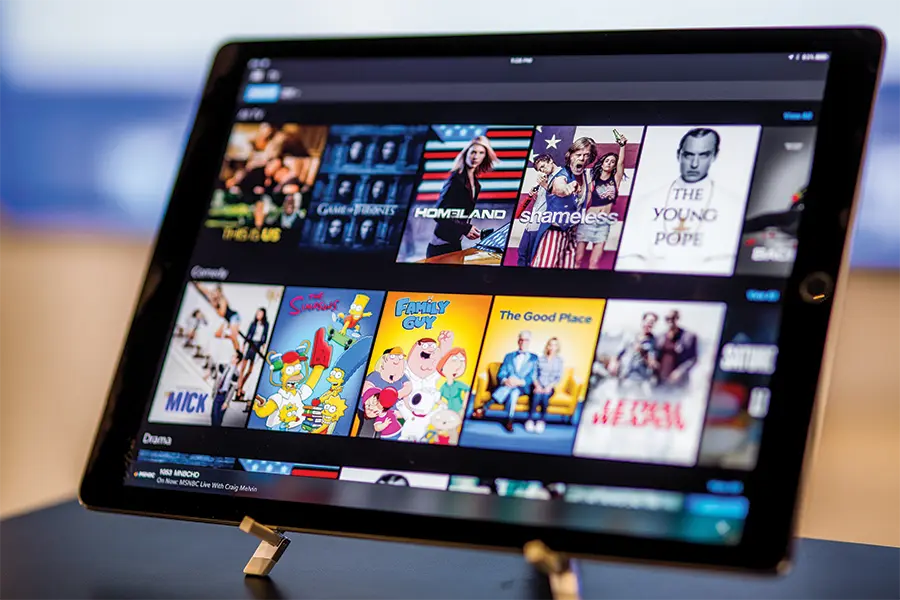The Deep Dive: Understanding the Xfinity Internet & Cable TV Plans Structure
Xfinity’s offerings rely on a powerful coaxial cable network, constantly being upgraded to offer speeds competitive with fiber. However, their primary business model revolves around bundled complexity.
The Tiered Internet Structure
Xfinity’s internet speeds are categorized to target different user needs, but seniors often overpay for speed they simply don’t use.
- Connect (75 Mbps) / Connect More (200 Mbps): This is the sweet spot. The Connect plan is more than enough for a single person to stream, email, and browse. Connect More handles multiple users and high-definition streaming comfortably. The crucial point: Do not pay for Gig speed (1000 Mbps) unless you run a home business or have a dozen data-intensive devices.
- The Download/Upload Disparity: Unlike fiber (Fios), Xfinity’s cable technology provides much slower upload speeds. While this isn’t a deal-breaker, it can slow down video calls and uploading large files, something to keep in mind if you heavily rely on sharing photos or hosting video meetings.
The Cable TV Labyrinth
Xfinity bundles cable TV into three main tiers, each adding cost and complexity:
- Basic/Limited Basic: Mandatory local broadcast channels. This is the lowest-cost, most straightforward option.
- Standard/Popular: Adds the most-watched news, sports, and entertainment channels.
- Premium/Ultimate: Adds specialty channels, movie channels (HBO, Showtime), and the highest cost. Smart seniors should focus on the Basic or Internet-Only plans.
Source:
- Xfinity Service Guide – Data Speed and Usage Tiers (2025)
- J.D. Power – Customer Satisfaction Survey: Residential Internet Service (2024)
The Savings Roadmap: Ways Seniors Can Unlock Discounts
While Xfinity does not advertise a blanket, nationwide “senior discount,” they actively participate in programs and offer specific low-cost plans that are designed for budget-conscious users, making these the most strategic entry points for older adults.
1. The Internet Essentials Program (The Game Changer)
This is Xfinity’s flagship low-income program and often the best deal available for seniors.
- Eligibility: This program is specifically designed for low-income households, including those receiving federal assistance like Supplemental Security Income (SSI), Medicaid, SNAP, or the VA Pension. Since many seniors qualify for these programs, they qualify for Internet Essentials.
- The Deal: It provides reliable, fast-enough internet service (often 50–100 Mbps) for a deeply discounted price, usually around $9.95 to $29.95 per month, often including the modem/router fee [Source: Xfinity Internet Essentials Program Guide, 2025].
2. The Affordable Connectivity Program (ACP) – Transition to Lifeline/Verizon Forward
While the federal ACP funding has largely concluded, the underlying assistance programs that made you eligible still exist.
- The Lifeline Bridge: The Lifeline program, which provides a $9.25 monthly discount on phone or internet service for low-income households (including those on SSI, Medicaid, etc.), is still active. Xfinity participates in Lifeline. You may still be able to combine Lifeline with an Internet Essentials plan for maximum savings.
3. The Digital Starter TV/Internet Bundle Strategy
If you absolutely need cable TV, focus on bundling the lowest-tier internet with the most basic TV package.
- The Tactic: Ask specifically for the bundle that includes the Connect More internet tier (200 Mbps) and the Limited Basic Cable (local channels). This often unlocks the lowest advertised bundle rate without saddling you with hundreds of channels you won’t watch.
Source:
- Federal Communications Commission (FCC) – Lifeline Program Eligibility
- Xfinity Connect Guide – Low-Cost Connectivity Options
Practical Application: The Negotiation and Setup Checklist
Finding the right plan is only half the battle. Seniors must control the hidden costs that creep into the final bill.
1. Beat the Equipment Rental Fee
The single biggest recurring fee is often the rental charge for the modem/router (Gateway), which can add $15–$25 per month.
- The Must-Do: Purchase your own Xfinity-compatible modem and router. While this is an upfront cost of $100–$150, it eliminates the monthly fee forever, saving hundreds over the life of the service. Ensure the model you buy is officially approved by Xfinity.
2. Lock Down the Contract Terms
Xfinity relies on sharp price increases after the promotional period (usually 12 or 24 months).
- The Question: When signing up, ask the representative: “What is the non-promotional, month-to-month price that my bill will automatically increase to?” Get this number in writing or note it down. Plan to call them back before that date to negotiate a new promotional rate.
3. Leverage Xfinity Mobile
If you use Xfinity for internet, you can access Xfinity Mobile (which uses Verizon’s network) for extremely low-cost mobile plans, often saving you far more than any cable discount.
- The Synergy: Xfinity Mobile offers low-cost, pay-per-gigabyte plans perfect for seniors who use their phones lightly, creating a massive, comprehensive savings opportunity across your entire communication budget.
Case Study: Marie’s Courageous Call
Marie, a 75-year-old widow in California, was receiving an Xfinity bill that crept up to $175 a month for an outdated triple-play package. She felt helpless.
- The Discovery: Marie’s daughter reviewed the bill and realized Marie was paying for a phone line she never used and a premium sports package she didn’t want.
- The Negotiation: They called Xfinity, canceled the TV and phone services entirely, and requested the Internet Essentials Plus plan (a slightly faster tier of the low-income program, available in her area). They also confirmed her continued eligibility for the Lifeline discount.
- The Win: Marie moved to a reliable 100 Mbps internet-only plan. Her new monthly bill, after discounts, dropped to $39.95. The savings allowed her to keep her separate, essential medical alert system subscription, transforming a monthly burden into a manageable, reliable cost.
Expert Traps: Common Mistakes that Cost Seniors Money
1. Ignoring the Data Cap
Many Xfinity plans have a 1.2 TB data cap. While this is generous for most seniors, heavy streamers or those who frequently upload large files might unknowingly incur overage charges.
- The Fix: Monitor your usage via the Xfinity app. If you consistently push the limit, ask about an Unlimited Data Option, which may cost an extra $20–$30/month, but prevents variable overage fees.
2. Falling for the Triple-Play Bundle
The Triple-Play (Internet, TV, Phone) is often advertised as the best deal, but it locks you into services you don’t need, making the eventual bill higher than two separate services.
- Expert Recommendation: Stick to the Double-Play (Internet + TV) or, better yet, Internet-Only. Use a mobile phone for voice calls and streaming services (Netflix, Hulu) for TV to avoid unnecessary fees.
3. Signing Up Without a Contract
While no-contract options offer flexibility, Xfinity often reserves the deepest discounts and the best price locks for customers who sign a 12-month or 24-month agreement. For seniors prioritizing cost stability, a short, fixed-term contract is often the financially wiser choice.
Advanced View: The Xfinity Home Integration
The modern Xfinity Internet & Cable TV Plans are the gateway to their Smart Home ecosystem. This integration can offer real value for older adults.
Xfinity Voice Remote
The Xfinity X1 platform, which powers their TV service, features an excellent voice-controlled remote. This is a powerful accessibility tool, allowing users to simply speak the channel number or show title, bypassing complicated menus and tiny buttons. The best plans include this feature.
Home Security and Monitoring
Xfinity Home offers integrated security, remote monitoring, and professional alert systems that leverage the home internet connection. For seniors living alone, this seamless, consolidated security platform can provide invaluable peace of mind.
Trends, Data, and Research: Shifting Power to the Consumer
Regulatory and market pressures are forcing providers like Xfinity to be more transparent and competitive with low-cost options.
The Rise of Fiber Competition
As Verizon Fios and local fiber providers expand, Xfinity is pressured to offer better price-for-speed ratios and improve customer service, directly benefiting consumers who shop around.
Government Funding for Access
Despite the end of the ACP, the underlying Lifeline program and state-specific programs remain crucial anchors for affordability. The industry is being forced to maintain low-cost tiers for eligible households [Source: Consumer Federation of America, 2024]. Smart seniors, or their advocates, must check these eligibility criteria first.
Comparison: Xfinity vs. Dedicated Low-Cost Plans
For budget-conscious seniors, the choice is usually between Xfinity’s standard plan and their own low-income offerings.
| Plan | Technology | Typical Speed | Monthly Cost Range | Best for |
| Xfinity Standard Bundle | Coaxial Cable | 400 Mbps + TV | $120 – $170 | High channel need, less budget constraint. |
| Xfinity Internet Essentials | Coaxial Cable | 50 – 100 Mbps | $9.95 – $29.95 | Strictly budget-focused seniors who qualify for assistance. |
| Xfinity Connect More | Coaxial Cable | 200 Mbps | $40 – $65 (Internet Only Promo) | The best balance of speed, reliability, and cost for the average senior. |
Common Questions and Concerns (Analysis and Explanation)
“Will Xfinity charge me a fee to install the service?”
Analysis: Yes, they often quote a professional installation fee (around $99 or more). However, this fee is often waived during promotions for new customers. Always ask the representative to waive the installation fee and opt for the Self-Installation Kit if you are comfortable with basic setup.
“How can I avoid the 1.2 TB data limit?”
Analysis: If you are an Internet Essentials customer, you typically do not have the 1.2 TB data limit. If you are on a higher-tier plan, you must either upgrade to the Unlimited Data Option for a monthly fee or switch to an alternative provider in your area (like Fios or T-Mobile 5G Home Internet) that offers unlimited data without an extra charge.
“Can I keep my landline phone number if I cancel Xfinity’s Voice service?”
Analysis: Yes, you can use a process called porting. You can transfer (port) your old landline number to a low-cost VoIP service (like Ooma or Vonage) or even to a basic mobile phone plan. This retains your long-used number while eliminating the high monthly charge of the Xfinity Voice service.
Conclusion: Clarity Brings Savings
The most powerful tool against an overinflated bill is knowledge. By understanding the true value of speed, leveraging programs like Internet Essentials and Lifeline, and wisely controlling equipment and contract fees, seniors can dramatically reduce the cost of their Xfinity Internet & Cable TV Plans. Don’t pay for what you don’t use, and never accept the first price quoted.
Take control of your budget today. Your next essential action: Call Xfinity’s customer service line and ask two specific questions: 1) “Do I qualify for the Internet Essentials program?” and 2) “What is the final, all-inclusive monthly price for the 200 Mbps Internet-Only plan with my own modem?” Demand clarity, and watch the savings appear.
About the Author
As a Senior Copywriter and Content Strategist, the author’s professional background, including a tenure at Apple, focuses on translating complex consumer contracts and pricing structures into clear, empowering financial narratives. This expertise is leveraged here to dissect the opacity of Xfinity Internet & Cable TV Plans, guiding seniors and their caregivers toward strategic, cost-saving decisions based on transparency and market reality.
References
- Xfinity Internet Essentials Program Guide. (2025). Eligibility and Service Tiers for Low-Income Households.
- Federal Communications Commission (FCC). (2025). Lifeline Program Overview and Eligibility Criteria.
- J.D. Power. (2024). Residential Internet Service Provider Customer Satisfaction Study, Highlighting Value and Reliability.
- Consumer Federation of America. (2024). Advocacy and Analysis of Low-Income Broadband Programs.
- Xfinity Service Guide. (2025). Data Usage Thresholds and Equipment Rental Fees.
- Xfinity Mobile. (2025). Mobile Plan Pricing and Requirements for Existing Xfinity Internet Customers.
- CNET. (2024). Review and Comparison of Internet Service Provider Modems and Routers.
- AARP. (2025). Essential Connectivity Needs for Older Adults and Telehealth Access.

